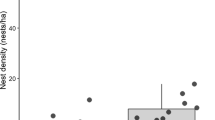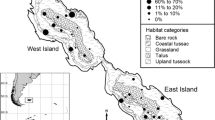Abstract
Rats (Rattus spp.) are among the most successful alien predators brought to islands by humans and have had devastating impacts on numerous seabird populations, but studies demonstrating rates of consumption and ecological impacts on penguins are scarce and mostly based on anecdotal evidence. We investigated the effects of rat predation on Humboldt Penguins (Spheniscus humboldti) by simulating unattended clutches with domestic Chicken eggs. Experiments were independently set at two Humboldt Penguin colonies in north (Pájaros Island, 29°S) and central Chile (Algarrobo Island, 33°S). At both colonies, eggs were primarily predated by rats (Rattus rattus = 70.8 % at Pájaros and Rattus norvegicus = 52.6 % at Algarrobo), and secondarily by Kelp Gulls (Larus dominicanus = 9.7 % at Pájaros and 15.8 % at Algarrobo). Significantly more eggs were predated at night. At both colonies, rates of rat and gull predation were highest within the first 12 h. Our study constitutes the first quantification of rats as important alien predators at Humboldt Penguin colonies. We suggest that rat presence at Humboldt Penguin colonies coupled with events that can cause temporary nest abandonment, such as human perturbation and El Niño events, may impact on the species’ breeding success. Eradication of rats is suggested to improve the nesting habitat of this and other threatened and endemic seabird species in the region.
Zusammenfassung
Wie sehr räubern Ratten in Kolonien des Humboldt-Pinguins ( Spheniscus humboldti ) in Nord- und Zentral-Chile
Ratten (Rattus spp.) gehören zu den erfolgreichsten Räubern, die von Menschen auf Inseln eingeschleppt wurden, und sie hatten bereits verheerende Auswirkungen auf viele Seevögel-Populationen; dennoch liegen nur wenige Untersuchungen über den Grad der Vernichtung und der ökologischen Folgen für Pinguine vor und gehen in der Regel über anekdotische Belege hinaus. Wir untersuchten die Auswirkungen des Räuberns von Ratten unter Humboldt-Pinguinen (Spheniscus humboldti), indem wir mit Eiern von Haushühnern unbewachte Gelege vortäuschten. Die Experimente wurden unabhängig voneinander in zwei Kolonien von Humboldt-Pinguinen in Nord- (Pájaro-Inseln, 29°S) und in Zentral-Chile (Algarrobo-Inseln, 33°S) durchgeführt. In beiden Kolonien wurden die Eier in erster Linie von Ratten (Rattus rattus = 70.8 %, Pájaro-Inseln, und Rattus norvegicus = 52.6 %, Algarrobo-Inseln) und an zweiter Stelle von Dominikanermöwen (Larus dominicanus = 9.7 %, Pájaro- und 15.8 %, Algarrobo-Inseln) erbeutet. Nachts wurden deutlich mehr Eier geraubt, und in beiden Kolonien erbeuteten sowohl die Ratten, als auch die Möwen die meisten Eier in den ersten 12 Stunden. Unsere Studie ist die erste quantitative Untersuchung zu Ratten als wichtigem eingeschlepptem Räuber in Kolonien von Humboldt-Pinguinen. Das Auftreten von Ratten in Kolonien des Humboldt-Pinguins kann unseres Erachtens in Verbindung mit Ereignissen wie Störungen durch Menschen oder durch Faktoren um El Niño, die das temporäre Verlassen von Gelegen bewirken, Auswirkungen auf den Bruterfolg der Art haben kann. Wir regen die Ausrottung der Ratten dort an, um das Brutgebiet dieser und anderer einheimischer, bedrohter Seevogelarten in der Region zu verbessern.


Similar content being viewed by others
References
Araya B, Garland D, Espinoza G, Sanhueza A, Simeone A, Teare A, Zavalaga C, Lacy R, Ellis S (eds) (1999) Taller de análisis de la viabilidad del habitat y de la población del pingüino de Humboldt (Spheniscus humboldti). Informe final, IUCN/SSC Conservation Breeding Specialist Group, Apple Valley
Berry L, Lill A (2003) Do predation rates on artificial nests accurately predict predation rates on natural nests? The effects of nest type, egg type and nest-site characteristics. Emu 103:207–214
Birdlife International (2000) Threatened birds of the world. Lynx, Barcelona
Blight LK, Ryder JL, Bertram DF (1999) Predation on rhinoceros auklet eggs by a native population of Peromyscus. Condor 101:871–876
Brooke ML, O’Connell TC, Wingate D, Madeiros J, Hilton GM, Ratcliffe N (2010) Potential for rat predation to cause decline of the globally threatened Henderson petrel Pterodroma atrata: evidence from the field, stable isotopes and population modelling. Endang Species Res 11:47–59
Culik B, Hennicke J, Martin T (2000) Humboldt Penguins outmanoeuvring El Niño. J Exp Biol 203:2311–2322
Davidson WB, Bollinger E (2000) Predation rates on real and artificial nests of grassland birds. Auk 117:147–153
Davis LS, Renner M (2003) Penguins. Poyser, London
DeGraaf RM, Maier TJ (1996) Effect of egg size on predation by white-footed mice. Wilson Bull 108:535–539
Ellenberg U, Mattern T, Seddon PJ, Luna-Jorquera G (2006) Physiological and reproductive consequences of human disturbance in Humboldt Penguins: the need for species-specific visitor management. Biol Conserv 133:95–106
Fry JC (1993) Biological data analysis: a practical approach. Oxford University Press, Oxford
Fukami T, Wardle DA, Bellingham PJ, Mulder CPH, Towns DR, Yeates GW, Bonner KI, Durrett MS, Grant-Hoffman MN, Williamson WM (2006) Above- and below-ground impacts of introduced predators in seabird-dominated island ecosystems. Ecol Lett 9:1299–1307
Gandini P, Frere E, Boersma D (1999) Nest concealment and its relationship to predation and reproductive success in the Magellanic Penguin at its southernmost continental colony. Ornitol Neotrop 10:145–150
Gaston AJ (2004) Seabirds, a natural history. Poyser, London
Hertel F, Martinez D, Lemus M, Torres-Mura JC (2005) Birds from Chungungo, Tilgo, and Pájaros islands in north-central Chile. J Field Ornithol 76:197–203
Hilton GM, Cuthbert RJ (2010) The catastrophic impact of invasive mammalian predators on birds of the UK overseas territories: a review and synthesis. Ibis 152:443–458
Imber MJ (1984) Exploitation by rats Rattus of eggs neglected by gadfly petrels Pterodroma. Cormorant 12:82–93
Jaksic F, Marti CD (1984) Comparative food habits of Bubo owls in Mediterranean-type ecosystems. Condor 86:288–296
Jones HP (2010) Seabird islands take mere decades to recover following rat eradication. Ecol Appl 20:2075–2080
Jones HP, Williamhenry Iii R, Howald GR, Tershy BR, Croll DA (2005) Predation of artificial Xantus’s murrelet (Synthliboramphus hypoleucus scrippsi) nests before and after black rat (Rattus rattus) eradication. Environ Conserv 32:320–325
Jones HP, Tershy BR, Zavaleta ES, Croll DA, Keitt BS, Finkelstein ME, Howald GR (2008) Severity of the effects of invasive rats on seabirds: a global review. Conserv Biol 22:16–26
Leimgruber P, McShea WJ, Rappole JH (1994) Predation on artificial nests in large forest blocks. J Wildl Manag 58:254–260
Lobos G, Ferres M, Palma A (2005) Presencia de los géneros invasores Mus y Rattus en áreas naturales de Chile: un riesgo ambiental y epidemiológico. Rev Chil Hist Nat 78:113–124
Luna-Jorquera G (1996) Balancing the energy budget for a warm-blooded bird in a hot desert and cold seas: the case of the Humboldt Penguin. PhD dissertation, Christian-Albrechts Universität, Kiel
Luna-Jorquera G, Hennicke J, Wallace R, Simeone A, Wolfaardt A, Whittington P, Ellis S, McGovern M (eds) (2002) Spheniscus penguin conservation workshop. Final report, IUCN/SSC Conservation Breeding Specialist Group, Apple Valley
Luna-Jorquera G, Fernandez CE, Rivadeneira MM (2012) Determinants of the diversity of plants, birds and mammals of coastal islands of the Humboldt Current systems: implications for conservation. Biodivers Conserv 21:13–32. doi:https://doi.org/10.1007/s10531-011-0157-2
Martin J-L, Thibault J-C, Bretagnolle V (2000) Black rats, island characteristics, and colonial nesting birds in the Mediterranean: consequences of an ancient introduction. Conserv Biol 14:1452–1466
Moors PJ, Atkinson IAE (1984) Predation on seabirds by introduced animals and factors affecting its severity. In: Croxall JP, Evans PGH, Schreiber RW (eds) Status and conservation of the world’s seabirds. In: International council for bird conservation technical publication no. 2, Cambridge, pp 667–690
Navarrete SA, Castilla JC (1993) Predation by Norway rats in the intertidal zone of central Chile. Mar Ecol Prog Ser 92:187–199
Newton I (1998) Population limitation in birds. Academic, London
Olson DM, Dinerstein E (1998) The global 200: a representation approach to conserving the earth’s most biologically valuable ecoregions. Conserv Biol 12:502–551
Paredes R, Zavalaga C (2001) Nesting sites and nest types as important factors for the conservation of Humboldt penguins (Spheniscus humboldti). Biol Conserv 100:199–205
Paredes R, Zavalaga C, Boness DJ (2002) Patterns of egg laying and breeding success in Humboldt Penguins (Spheniscus humboldti) at Punta San Juan, Peru. Auk 119:244–250
Prieto J, González-Solís J, Ruiz X, Jover L (2003) Can rats prey on gull eggs? An experimental approach. Biodivers Conserv 12:2477–2486
Rangen SA, Clark RG, Hobson KA (2000) Visual and olfactory attributes of artificial nests. Auk 117:136–146
Reise D (1973) Clave para la determinación de los cráneos de marsupiales y roedores chilenos. Gayana 27:1–20
Schlatter RP (1984) Status and conservation of seabirds in Chile. In: Croxall JP, Evans PGH, Schreiber RW (eds) Status and conservation of the world’s seabirds. In: International council for bird conservation technical publication no. 2, Cambridge, pp 261–269
Schlatter RP (1987) Conocimiento y situación de la ornitofauna en las islas oceánicas chilenas. In: Castilla JC (ed) Islas oceánicas chilenas: conocimiento científico y necesidades de investigaciones. Ediciones Universidad Católica de Chile, Santiago, pp 271–285
Simeone A, Bernal M (2000) Effects of habitat modification on breeding seabirds: a case study in central Chile. Waterbirds 23:449–456
Simeone A, Araya B, Bernal M, Diebold EN, Grzybowski K, Michaels M, Teare JA, Wallace RS, Willis MJ (2002) Oceanographic and climatic factors influencing breeding and colony attendance patterns of Humboldt penguins Spheniscus humboldti in central Chile. Mar Ecol Prog Ser 227:43–50
Simeone A, Luna-Jorquera G, Bernal M, Garthe S, Sepúlveda F, Villablanca R, Ellenberg U, Contreras M, Muñoz J, Ponce T (2003) Breeding distribution and abundance of seabirds on islands off north-central Chile. Rev Chil Hist Nat 76:323–333
Smith DHV, Wilson DJ, Moller H, Murphy EC (2008) Using artificial nests to explore predation by introduced predators inhabiting alpine areas in New Zealand. N Z J Zool 35:119–128
Thibault J-C (1995) Effect of predation by the black rat (R. rattus) on the breeding success of Cory’s shearwater Calonectris diomedea in Corsica. Mar Ornithol 23:1–10
VanderWerf EA (2001) Rodent control decreases predation on artificial nests in O’ahu ‘Elepaio habitat. J Field Ornithol 72:448–457
Whelan CJ, Dilger ML, Robson D, Hallyn H, Dilger S (1994) Effects of olfactory cues on artificial-nest experiments. Auk 111:945–952
Williams TD (1995) The penguins. Oxford University Press, Oxford
Yorio P, Boersma PD (1994) Consequences of nest desertion and inattendance for Magellanic penguin hatching success. Auk 111:215–218
Zamorano JH (1986) Rattus rattus (Rodentia, Muridae) un depredador intermareal poco conocido. Medio Ambiente 8:58–62
Acknowledgments
We are indebted to R. Wallace (Milwaukee County Zoo, Milwaukee, USA) for logistical and financial support at Algarrobo. The Consejo de Monumentos Nacionales (Ministry of Education) provided permission for field work on Algarrobo and the Cofradía Náutica del Pacífico facilitated access to the island. Martin Thiel, Vincent Bretagnolle and an anonymous reviewer made valuable comments on this manuscript. On Pájaros, field work was supported by research grant no. 1010250 provided by FONDECYT to Guillermo Luna-Jorquera. We also thank M. Bernal and E. Hanshing for their valuable help in the field. Experiments comply with the current Chilean law.
Author information
Authors and Affiliations
Corresponding author
Additional information
Communicated by P. H. Becker.
Rights and permissions
About this article
Cite this article
Simeone, A., Luna-Jorquera, G. Estimating rat predation on Humboldt Penguin colonies in north-central Chile. J Ornithol 153, 1079–1085 (2012). https://doi.org/10.1007/s10336-012-0837-z
Received:
Revised:
Accepted:
Published:
Issue Date:
DOI: https://doi.org/10.1007/s10336-012-0837-z




